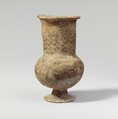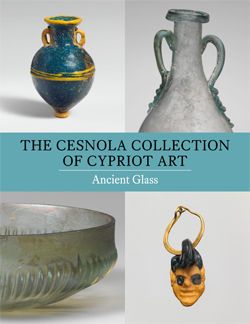Glass krateriskos (unguent jar)
Not on view
Translucent blue, with opaque white trail(s).
Thickened and rounded rim with everted horizontal lip; tall cylindrical neck, tapering slightly downward; sloping shoulder; bulbous body; pedestal foot, conical, then tooled out into a flat, circular pad; uneven bottom with central kick; on opposite sides of body, two loop handles, applied over trail decoration.
Marvered trail(s) on neck and body, tooled into a festoon pattern.
Broken and repaired, with part of rim and neck missing, a large hole in one side of body, and most of handles lost; thick creamy enamel-like weathering covering all of surfaces, with some soil encrustation on interior.
Among Bronze Age imports into Cyprus from Egypt were glass containers that held perfumes, scented oils, or cosmetics used for funeral purposes. Afterward, the jars were left in the burials. Such jars have been found on Cyprus at Kalavassos in tombs of the fourteenth century B.C. An additional example with a pristine unweathered surface can been seen nearby.
This image cannot be enlarged, viewed at full screen, or downloaded.


